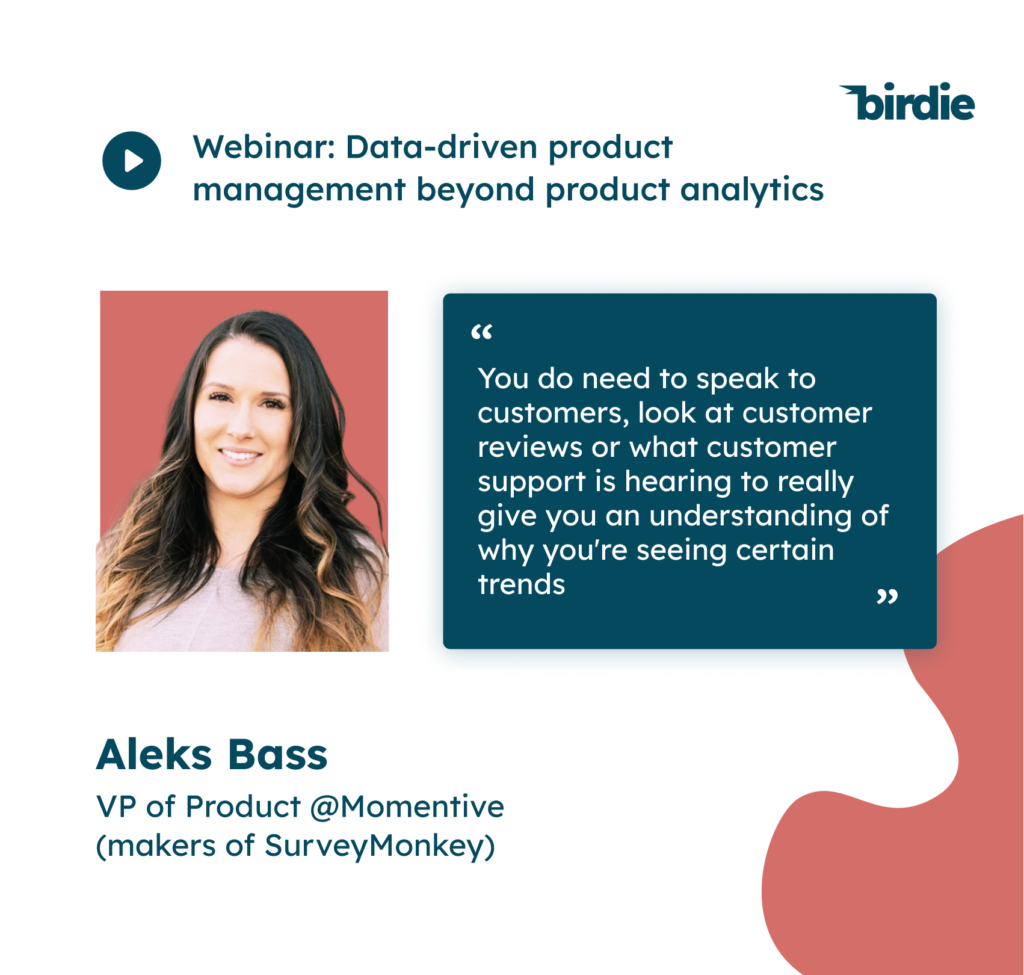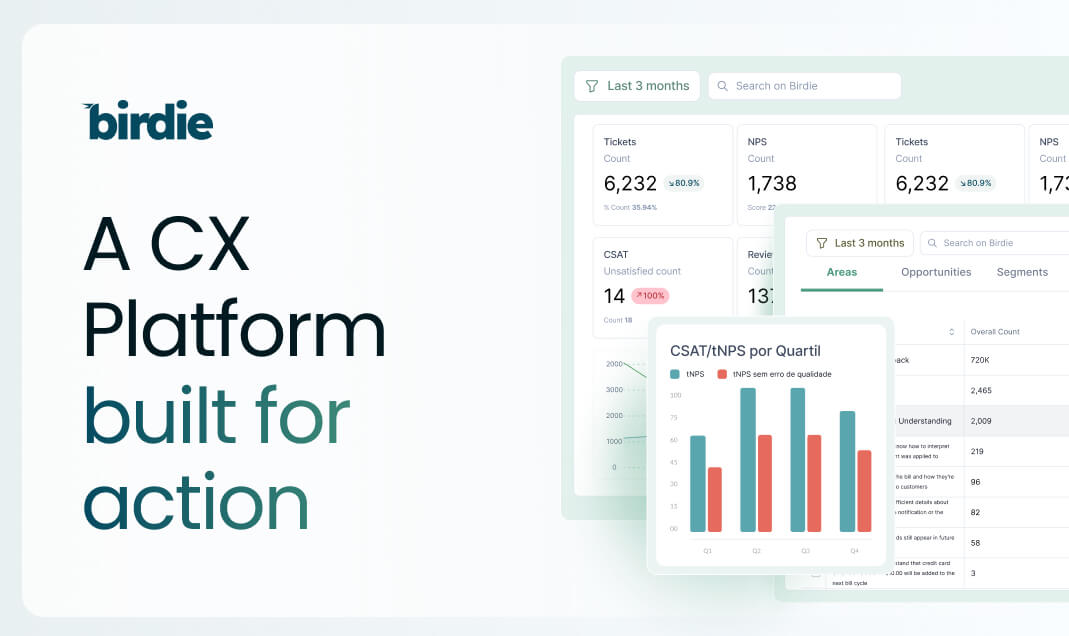

In our most recent webinar, we had the pleasure of welcoming Aleks Bass, VP of Product at Momentive (makers of SurveyMonkey), and Marc Abraham, former Group Product Manager at Intercom - both listed among the 2023's Top 75 Product Management mentors to learn from, to discuss how to use data to support your product strategy and roadmapping.
Among several tips and how to's, here are the 5 key takeaways from this conversation:
- Data should inform rather than drive your strategy
- Your metrics change, but your need to deeply understand users doesn't
- Getting value from user feedback is complex but should be a priority
- A product operations team can help with better processes
- Running a cycle of feedback analysis helps to kickstart the process
Continue reading for the full insights from the conversation and for a challenge to help you uplevel how you use data today.
Being intentional about how you want to use the data is critical - data informs product strategy rather than drives
Until not long ago, companies didn't have a lot of data to rely on. When data started to become available - some would say abundant - a lot of product folks started using the word data-driven, which pretty much means that the data drives your decisions; you just follow the trail of the data.
The problem with that approach, according to Aleks Bass, VP of Product at Momentive, is that "sometimes that data leads you to a place that doesn't make any sense when analyzed within the strategy of your organization". That's why data-informed is the best approach: you use data to give you a perspective about things, but also bring your own point of view, your experience, and your product intuition to the table when analyzing that data to make decisions.
For both of the panelists, the ideal approach is to think about what you're trying to answer and use the data to inspire you and help you answer a question and validate (or not) a hypothesis versus just trying to find a story in the data.
Not to mention that a lot of organizations don't even have the right data available to use, or don't know which data sets to look at. "We have to be really crisp about what we want to learn, and typically the harder part is finding the data and organizing it. Then linking the data is easier, especially if I know what questions I have", completes Marc Abraham, former Group Product Manager at Intercom.
Your success metrics will change, but you'll always have to deeply understand your customer
Defining your success metrics and KPIs depends on a lot of variables: your strategy, the context, who's your customer, what tools you have, what skills your team has, which data you have access to. But, for both Aleks and Marc, one thing doesn't change: understanding what is generating value for the user.
According to Momentive's VP of Product, the two main pillars of analysis are product usage - what people are using - and user satisfaction - what is their feedback about their experience. Given her background in research, Aleks said she "likes to plug in data from multiple sources on a regular basis to understand users' perception of value and leverage it more strategically".
Marc adds to it by saying that a lot of usage metrics are lagging indicators, finding the leading indicators that really move the needle is key, and that it normally means listening to customers. For him, combining product analytics with feedback analytics can help you build a story and answer important questions: "I think that there's a disconnect between understanding the factual experience of your customers versus understanding their experiential perceptions".
"You do need to speak to customers, look at customer reviews or what customer support is hearing to really give you an understanding of why you're seeing certain trends from an acquisition point of view or why people are churning because the pure hard analytics more often than not won't give you that", Aleks completes.

Getting value from user feedback is a multiple-layer challenge that needs to be prioritized in your product strategy
There are different layers of challenge when it comes to systematically analyzing qualitative user feedback. The first is the fact that there are lots of data centralized in different systems. Creating a feedback river solves this first challenge, but brings others to the table that need to be solved.
Aleks shares her experience, stating that the challenges are many as not everybody feels as comfortable with all the different data sources and people will have confirmation biases and look for data that's going to prove one good idea that they have.
She suggests that a good approach is to "push your team to not leverage data solely as a validation exercise but really to use it as an opportunity to pressure test the idea, using the data to zoom out and find other opportunities to explore and understand that this might have less of an impact than this other thing that I'm not even considering exploring".
For that, having a customer feedback analytics platform that gives you the flexibility to run different analyses and explore the data in different ways is very important.
Marc completes that a big piece of the challenge is educating people on how to use the data, as "things don't happen in isolation and you need to think about a system and combine different aspects of the product usage and feedback".
Product operations can make your life easier
When asked about the role of product operations in building a data-informed culture, Marc has a strong opinion: "The first thing to highlight is that absence of data cannot be a showstopper for evolving your product, and the absence of Product Ops cannot be an excuse for not having data".
He believes that Product Ops start to make sense in an organization with 10 plus product managers that might benefit from a centralized kind of product function. He continues by saying that "product operations is a new function that has different formats in each organization. In one of my experiences, we started Ops to create a centralized dashboard and avoid our PMs having to constantly look for and create new subsets of data.".
This is a common challenge in most organizations; they have siloed data that is not easy to access nor to work with, especially regarding user feedback. Breaking this friction can be an important part of a Product Operations role, whose key responsibilities are around bringing efficiency on product development life cycle processes that bring maturity to the organization as a whole, especially when it comes to understanding users' needs.
Adding to that point, Aleks states that "anytime you're trying to take a group of product managers who are all working on a subset of the same product and trying to get to a better holistic experience for the customer without a process that is consistent across the board you run into trouble". Bringing agility to the whole product lifecycle is, for her, a critical element. "Getting to a place where I have consistency across the board so that when you're onboarding new talents it's easier to walk them through here's what our process looks like, here are the sources of data that we use, here is our historical feedback and more, can add tons of value", she continues.
For both, data consistency and alignment help reduce friction on the decision-making side and help you have more confidence in roadmap prioritization and stakeholder negotiations. Aleks finishes by saying that she is a big proponent of Product Ops because "ops can really make an impact and drive a roadmap around what data the team needs, where to find it, which frameworks to use, and how to get more efficiently to better outcomes."
An exercise to accelerate the implementation of a customer-centric and data-informed approachs
"One of the biggest challenges that I've seen for product managers is in the ability to translate the effort they are putting into changing elements of the product to the financial impact it's going to have for the organization as a whole". That's how Aleks started to answer a question about implementing a data-informed culture. For her, having data is critical to not only support your decisions but also to measure their impact.
In her opinion, getting the buy-in of important stakeholders is a very relevant aspect of using data as part of your product management system. She also has a strong point of view about building homegrown product analytics and feedback analytics solutions: "they start to track things at such a detailed level that they get overwhelmed by the amount of data and don't even know what to do". Aleks continues by saying that creating a safe space where not only is data access democratized, but people can also share their insights, have open discussions, and combine different versions of how they're looking at the data is crucial for the organization as well.
She then suggests an exercise: telling your team to spend a sprint going through user feedback and usage data to document gaps and come up with one thing in their backlog to be something inspired by the data, either as a new feature or as a challenge that they have a hypothesis of how to address. From there, they can get to a baseline of a relevant metric - NPS, for example - and start monitoring the changes.
"Even if nothing changes, this approach will show the team that using the data is not as hard as it is important and helpful to learn and measure things, and they can start doing this again, and again, and again", she says, "until six months from now they say: wow, we're much more data-informed today than before".
Want to challenge yourself and your team to do that exercise? Request free access to Birdie Feedback Analytics Beta and start that right now.
Bonus: product tools mentioned during the roundtable
- SurveyMonkey to run surveys and capture user perspective
- Pendo and Amplitude as product analytics tools
- Zendesk and Intercom to manage support tickets
- Gong to transcribe and analyze sales and CS calls
- Optimizely to design and optimize experiments
- Birdie as the user feedback repository, search, and analysis platform
- Slack as an important information distribution tool based on triggers from all these other sources.








